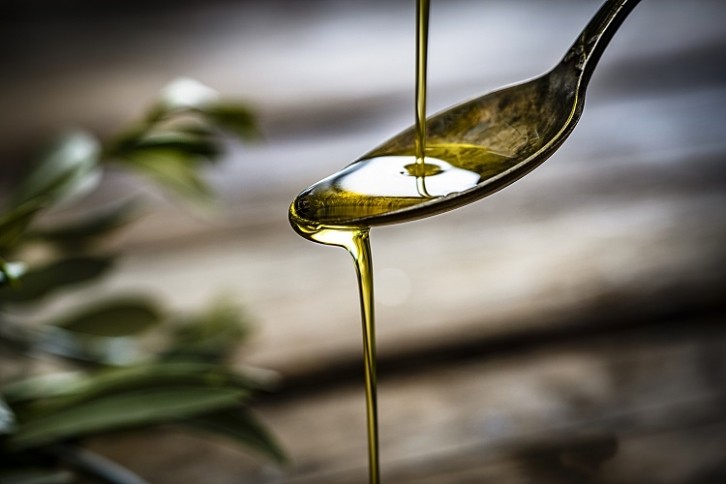Should extra virgin olive oil receive Nutri-Score ‘A’?

A staple of the Mediterranean diet, extra virgin olive oil boasts an array of health benefits.
It’s high in monounsaturated fatty acids (which compared to saturated fat helps lower ‘bad’ LDL cholesterol levels), contains antioxidants with anti-inflammatory properties, and has even been linked to lower risks of cardiovascular disease, some cancers, and dementia.
But as it stands, extra virgin olive oil can at best achieve a ‘B’ ranking according to front-of-pack nutrition labelling system Nutri-Score. Is it right that the healthiest of the edible oils can never achieve a perfect Nutri-Score?
Separating extra virgin olive oil from other processed oils
In Greece, the world’s third largest producer of olive oil, industry is calling for extra virgin olive oil to move up the Nutri-Score ranks.
According to the Exporters Association of Crete, where 200,000 tons of extra virgin olive oil is produced every year, the oil is deserving of a Nutri-Score ‘A’. The association argues that it’s a ‘completely natural, single-ingredient food’ with ‘unparalleled health benefits’.
The product is also backed by health claims from the European Food Safety Authority (EFSA) and the US Food and Drug Administration (FDA).
That does not mean all processed oils deserve the Nutri-Score A ranking in the eyes of the Exporters Association of Crete, however. It’s calling for other processed oils to be displayed in a lower category.
“It’s obvious that any degradation of the natural and single ingredient ‘pillar’ foods of the Greek/Mediterranean diet that are the most affected, like extra virgin olive oil, virgin olive oil, and honey, will undermine the consumer’s...perspective of a healthy and balanced diet,” believes the association, which also raises concerns about these products’ ‘commercial future’, particularly in markets where ‘relevant knowledge is low’.
‘Nutri-Score should incorporate degree of processing’
The association is also calling for Nutri-Score to incorporate a product’s degree of processing, as well as its environmental footprint, into the algorithm.
What makes extra virgin olive oil the healthiest of the edible oils?
Edible oils come from various sources, ranging from nuts to seeds and fruits. Since their nutritional quality can vary greatly, researchers recently developed an algorithm designed to rank edible oils out of 100.
All plant oils, except for margarine and coconut oil, ranked above the 50th percentile. But of the 32 edible oils evaluated, virgin olive oil ranked first with a score of 100.
Assessing degree of processing is mostly done using the Nova classification system, but the association is open to other methods. According to Nova, there are four levels of food processing: from raw and minimally processed foods; to processed culinary ingredients; processed foods; and ultra-processed foods.
Members of the Exporters Association of Crete are not the first to suggest Nutri-Score be linked to Nova or a degree of processing metric. Researchers from Université of Sorbonne Paris Nord and France’s public health agency (Santé Publique France) recently acknowledged that further research is needed to identify the mechanisms by which ultra-processed food affects health and how it interacts with nutritional quality.
“Such information is required if we want in the future to further upgrade the Nutri-Score algorithm by integrating both dimensions. Meanwhile, health authorities should communicate on how to use Nutri-Score adequately, while promoting the consumption of minimally processed foods.”
As the Nutri-Score algorithm changes, so does the extra virgin olive oil ranking
Nutri-Score has not always given extra virgin olive oil a ‘B’ ranking.
When the algorithm was first developed, extra virgin olive oil ranked ‘D’. But algorithm updates over the years have seen this ranking improve, from an orange ‘D’ to a yellow ‘C’, and as of January this year, to a light green ‘B’.
How does the Nutri-Score algorithm work?
Nutrition labelling scheme Nutri-Score was developed in France in 2017. Its algorithm ranks food from –15 for the ‘healthiest’ products to +40 for those ‘less healthy’. Based on this score, the product receives a letter with a corresponding code: from dark green (A) to dark orange (E).
But the Exporters Association of Crete laments that ‘despite the latest revision’, extra virgin olive oil has still not reached the level ‘it deserves’. “In fact, the new version of Nutri-Score still does not communicate the rich complexity of beneficial ingredients and the nutritional superiority of extra virgin and virgin olive oil, as proven by multiple scientific studies and research.
“In addition, in the same category ‘B’, virgin olive oils coexist with other oils that are processed and with a clearly inferior nutritional profile – such as pomace oil, simply olive oil, canola oil, and sunflower oil,” notes the association members.
What's the difference between olive oil, virgin olive oil, and extra virgin olive oil?
To make olive oil, olives are heated and their oil extracted.
Both virgin and extra virgin olive oils are made without heat or solvents. Instead, the oil is extracted using mechanical methods only. After extraction, the oil is graded.
If the olive oil contains minimal defects and has a free acidity of between 0.8 and 2.0, it is graded as virgin olive oil.
If the olive oil contains no defects and boasts a fee acidity less than or equal to 0.8, it is graded as extra virgin olive oil.
The Crete Exporters Association, like others producing traditional, single ingredient foods around Europe – such as makers of cheese in Italy or meats in Spain – also takes issue with Nutri-Score's assessment of products per 100g. This amount ‘far exceeds’ the daily recommended consumption of oilve oil, stresses the association.
“In fact, the maximum daily intake of olive oil per person within EU countries is only 30g...”
The argument against olive oil receiving a Nutri-Score A ranking
FoodNavigator took the Exporters Association of Crete’s proposals to Serge Hercberg (who helped devise Nutri-Score), professor of nutrition at the Université of Sorbonne Paris Nord, for his take on whether extra virgin olive oil should be upgraded to a Nutri-Score A.
Professor Hercberg did not agree, suggesting that the association had financial, rather than health, interests in mind.
Has Greece adopted Nutri-Score?
No, Greece hasn’t made yet decided whether it will formally adopt Nutri-Score as its voluntary front-of-pack labelling scheme. However, since Greek foods are exported into other EU countries, some products carry the Nutri-Score ranking.
“It is not up to private actors who defend their economic interests to set the rule of the game for a public health tool like Nutri-Score, and therefore to require that their products be well classified,” he told FoodNavigator.
“Olive oil has always been classified in the best possible category for a vegetable oil. No oil is classified A... The classification of all olive oils as Nutri-Score B perfectly values the olive oil.”
Professor Hercberg believes consumers value the Nutri-Score B ranking and would not be put off buying extra virgin olive oil because it does not receive Nutri-Score A. “B is considered a very good classification by consumers – especially in a category without products classified A.”


























